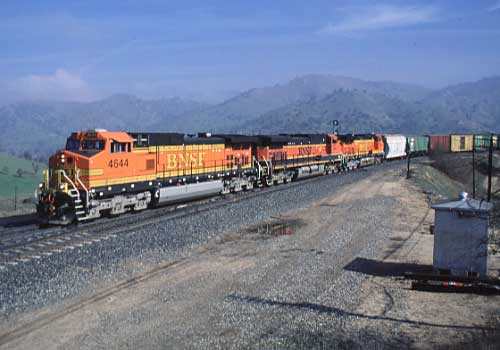Burlington Northern had been formed on March 1, 1970 by the merger of Chicago, Burlington & Quincy; Great Northern; Northern Pacific; and Spokane, Portland & Seattle. BN operated in three principal corridors: Chicago and Minneapolis-St. Paul (the Twin Cities) to Portland and Seattle in the Pacific Northwest; Chicago to Omaha, Denver and Montana, including the coal-rich Powder River Basin in Wyoming; and from Denver, Kansas City, St. Louis to Dallas-Fort Worth, Memphis, and Birmingham, Ala. On November 21, 1980, BN acquired the St. Louis-San Francisco Railway (the Frisco), once owned by the Santa Fe in the 1890’s, whose main lines formed an X from St. Louis through Oklahoma to Texas and from Kansas City to Birmingham and Pensacola, Fla., (making BN and successor BNSF a true transcontinental railroad).
The Atchison, Topeka & Santa Fe Railway Company was chartered in 1859 and operated under that name, or its better known nickname “The Santa Fe,” since 1863. The Santa Fe stretched from Chicago via Kansas City and Albuquerque to California, serving the Los Angeles and San Francisco areas, plus Denver, Phoenix, and extensive parts of Oklahoma and Texas.
BNSF announced its intent to merge with Canadian National on December 20, 1999, creating a 50,000-mile rail network. In response, the Surface Transportation Board imposed a 15-month moratorium on rail mergers on March 17, 2000, in order to rethink the rules under which future merger proposals would be evaluated. As a result, BNSF and CN called off their proposed merger on July 20, 2000.
Commodities
Each day, BNSF originates between 40 and 60 loaded coal trains from Powder River Basin mines in northeastern Wyoming and southeastern Montana, with an equal number of empty trains arriving to be reloaded. Other coal-producing regions served by BNSF include Colorado, Illinois, New Mexico, and North Dakota. In 2004, BNSF moved 255 million tons of coal.
Roughly two-thirds of the 80-100 daily trains that cross the Southwest on the ex-Santa Fe transcontinental main line are double-stack container trains and piggyback trains moving between the eastern gateways of Chicago, Kansas City, Memphis and Fort Worth, and the California terminals of San Bernardino, Los Angeles, Long Beach, Stockton, and Richmond. Intermodal traffic is also heavy on the Chicago-Fort Worth corridor, and between Chicago and the cities of Seattle and Portland, Ore.
Between August and November, BNSF handles nearly 2,000 cars of grain a day, originating in the Midwest, Great Plains and Pacific Northwest. Corn and wheat make up more than half of the railroad’s grain movements. The Minneapolis-Seattle corridor sees grain traffic headed for domestic producers and the ports of Seattle, Tacoma, and Vancouver, Wash.
Lumber shipments originate in the Pacific Northwest, Minnesota, and the Southeast U.S. Between California and the Pacific Northwest, BNSF hauls lumber, forest products, coiled steel, chemicals, and petroleum.
Burlington Northern Santa Fe Corporation
2650 Lou Menk Drive, 2nd Floor
P.O. Box 961057
Fort Worth, TX 76161-0057
(817) 333-2000
www.bnsf.com















My grandfather, EdG. Hardie fired for the Santa Fe around the turn of the century (1900). His
train that he was firing had a wreck in Pauls Valley, Oklahoma, the engineer, Kilpatrick, was killed and Ed jumped and survived. Probably early 1900’s. Any info to: Jim Compton, tex1836@icloud.com.
Oblige, Jim Compton
I did see a couple of passenger (Amtrak) trains heading towards Clinton, IA. Can you tell me what this is, or just a detour. Also, saw a passenger extra heading towards Chicago, with MU cars ( looked like M9’s) for the New Haven. Is there a manufacturing plant on the UP line?
Love to see a track plan of the Rochelle, IL junction! At one time, I actually saw an Amtrak Superliner train run through on the UP heading in a northernly direction. What train was that, and where is its final destination. Was it a detour?
PLEASE UPDATE THIS NARRATIVE AS IT SEEMS DATED AND DOES NOT INCLUDE INFORMATION ABOUT BAKKEN CRUDE SHIPMENTS
Back in late 40's my father was a fireman shoveling coal into the old steamers, for Santa Fe, at the age of 14 years old, he was so proud of that job, he got me hooked on trains at a young age.
Hey guys last week I went train watching in brunswick maryland! You can get really good train watching there seriously! I saw four trains in one hour!
Cool!
I've seen a Citirail C44-9W!
And four union pacific!
Plus 3 CP and one citirail!
We Men may Grow Old, But We'll Never really Grow-Up; not regarding Loving-TRAINS anyhow… LOL
More like two.
In my days I've only seen one BNSF engine and I wish to see more.
Interesting profile and appreciate the research that went into it! More on the Santa Fe should be added, as well as the FRISCO.